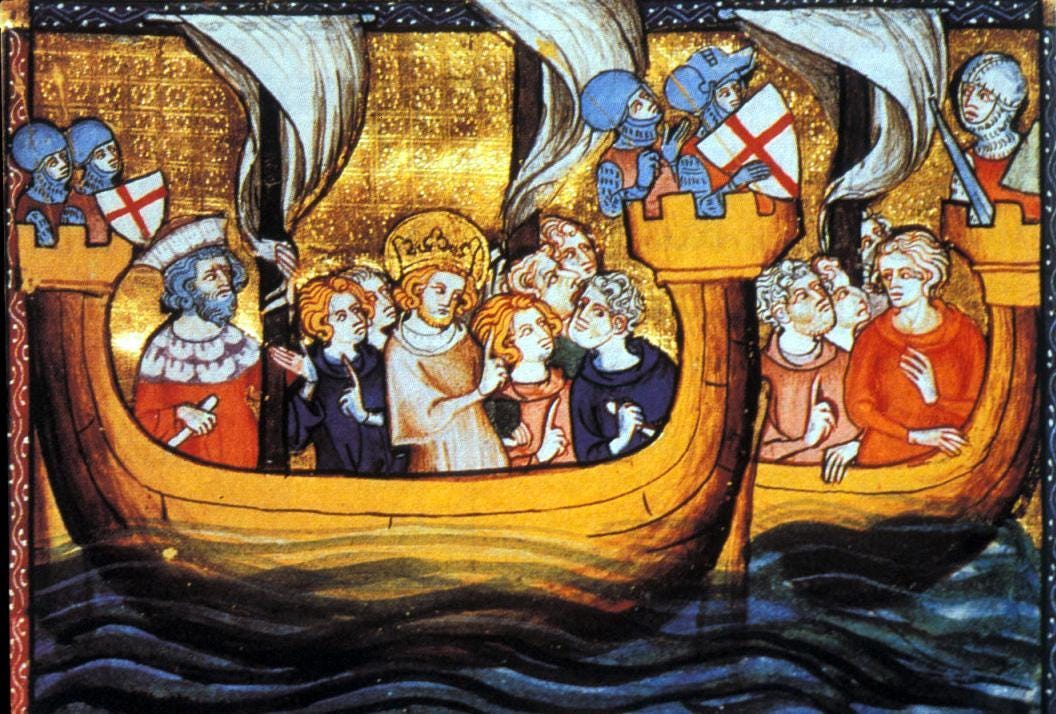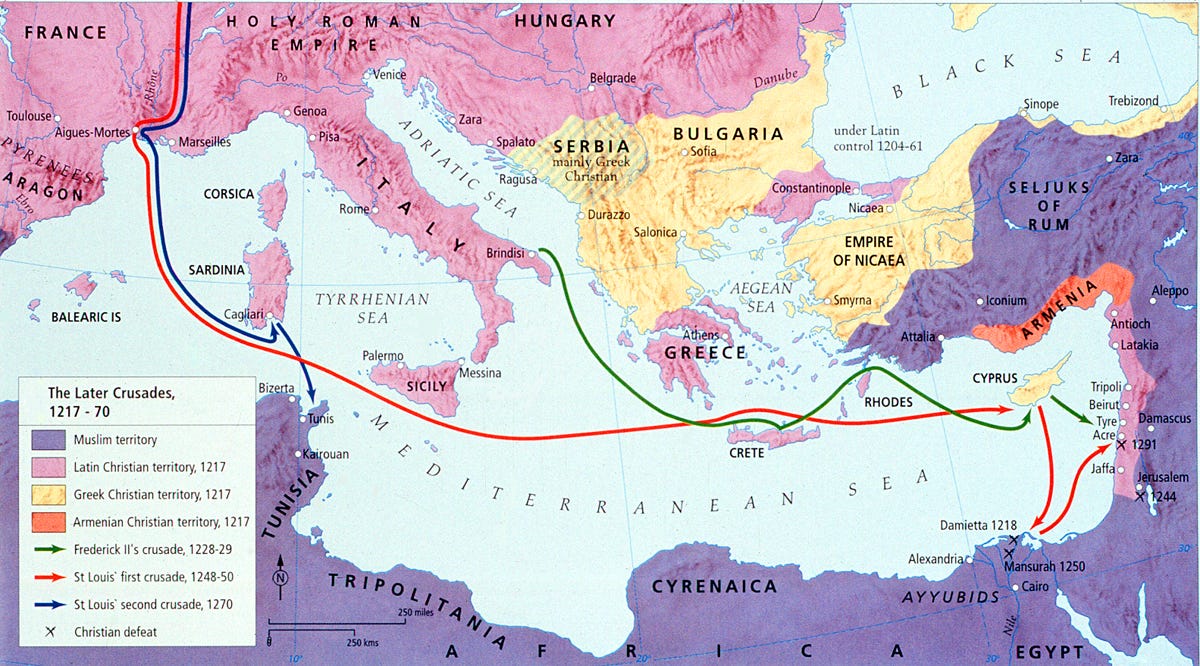Today in Middle Eastern history: the Battle of Mansurah begins (1250)
The beginning of the end of the Seventh Crusade.
If you’re interested in history and foreign affairs, Foreign Exchanges is the newsletter for you! Sign up for free today for regular updates on international news and US foreign policy, delivered straight to your email inbox, or subscribe and unlock the full FX experience:
Before King Louis IX of France (d. 1270) led the weirdly conceived and badly failed Eighth Crusade against Tunis, he earned his Crusader bona fides on the better conceived but still badly failed Seventh Crusade, which is our subject today. As I wrote when we talked about the Eighth Crusade, if medieval BuzzFeed had put together a list of the ten most swag Crusade leaders or whatever, Louis would have been near the top of the list if not right at the top. His piety was the stuff of legend and his commitment to the Crusading cause was unmatched even by his fellow luminary Richard the Lionheart. He was as central to the later Crusades movement as Godfrey of Bouillon (the first Crusader ruler of Jerusalem) was to the early Crusades movement. The thing is, though, while Godfrey was clearly successful and Richard was kind of successful, Louis was most definitely not successful. At all. Twice. But at least he was committed to the cause, and on the Seventh Crusade he brought along a very capable biographer, the famous chronicler Jean de Joinville.
King Louis later became Saint Louis, which serves as a sort of “at least you tried” consolation prize for his two big misadventures. His canonization wasn’t just about his career as a (pretty bad but very enthusiastic) Crusader, to be fair. He was known for his devotion to the Church in just about every walk of life. He built churches, for example, which the people who decide on things like canonization tend to appreciate. He often wore a hair shirt in penance for his sins, which isn’t something kings are widely known for doing. He ministered to lepers and to the poor, welcoming beggars (so we’re told, anyway) to his own table, which seems nice. He also enjoyed burning piles of the Talmud and ratcheting up punishments for blasphemy, which was not so nice but still got you brownie points as a medieval Christian. In general he took very seriously the French king’s traditional (going back to Charlemagne) role as the chief protector of the Roman Church. Sainthood was his reward.
One major difference between Louis and Richard is that Louis saw Crusading primarily as a religious obligation, where Richard saw it as a chivalric one. This may help to explain the different course their Crusades took. Richard’s Third Crusade was a military success that likely saved the Crusader states from being conquered, or at least dominated by, Saladin. It only failed to achieve its ultimate objective, the reconquest of Jerusalem, because the departure of the French and German armies left Richard without enough soldiers to attempt a siege. Louis’ Crusades, on the other hand, were just dismal failures. Admittedly, he “lost” the Eighth Crusade by dying in the middle of it, but he died of a bout of dysentery that was entirely the result of his decision to campaign in North Africa in the middle of summer, so I think that counts as a strategic failure. The 1248-1254 Seventh Crusade, on the other hand, highlighted his weaknesses on both the strategic and tactical levels.

The Battle of Mansurah is the first of two battles that ended the Seventh Crusade. This Crusade was modeled after the 1213-1221 Fifth Crusade, in that it acknowledged the strategic fact that no Crusader army could hope to capture and hold on to Jerusalem without first dealing with the Muslims who were ruling Egypt, which at the time (but not for very much longer) meant Ayyubid dynasty that Saladin had founded. The notion that Egypt was the key to Jerusalem started to become conventional Crusader wisdom during the Third Crusade, when Richard appealed to his army to give up on their main objective (temporarily) and invade Egypt, only to back down in the face of a potential mutiny. The Fourth Crusade had initially planned to invade Egypt, but then they decided to, you know, sack Constantinople instead. Close enough! Then the Fifth Crusade sailed straight to Egypt, but it collapsed after a much longer than expected siege of the port city of Damietta, an ill-conceived attempt to march on Cairo, and a lot of the infighting that by this point had practically become the Crusaders’ stock in trade.
I guess it could be considered an irony that repeated Christian military expeditions undertaken with the goal of securing Jerusalem mostly had the effect of destroying that city. Jerusalem was an Ayyubid possession from its conquest by Saladin until the 1228-1229 Sixth Crusade, in which the excommunicated Frederick II cut a deal with the Ayyubids to let him nominally take possession of the city without fighting, but also without controlling any of the surrounding towns or fortresses that would have made the city defensible. The 1239-1241 Barons’ Crusade, which didn’t get itself a number but was perhaps the most successful of all the Crusader campaigns other than the first one, did enlarge the territory of the Kingdom of Jerusalem, but the Ayyubids retaliated by inviting a Khwarazmian army, left homeless by the recent Mongolian conquest of their kingdom, to besiege Jerusalem in 1244. They not only took the city, they practically razed it to the ground. Louis’ immediate motivation, apart from an apparently sincere desire to go on Crusade, was that 1244 sacking.
Depending on your point of view, by 1248 the Ayyubids were either ripe for attack or beyond that point. The dynasty was clearly at its nadir, with its rulers having had most of their authority usurped by their mamluk slave soldiers. On the other hand, the rise of those mamluks had rejuvenated the sultanate’s bureaucratic and military core and insulated it from the effect of a series of weak and/or incompetent emperors. Indeed, the mamluk-led core was so strong that it eventually did away with the Ayyubid line altogether and the slaves (well, ex-slaves) began to rule in their own right, as what we now call the Mamluk Sultanate. This usurpation was a process that began not long after Mansurah, in fact, but took another decade to fully play out.
The Fifth Crusade had identified Damietta, a port located at the mouth of the Damietta branch of the Nile River, as the place to establish their foothold in Egypt, and they took it after a long (~18 month) siege. The wear and tear of that siege, plus some timely/untimely Nile flooding, had been the downfall of that invasion. Louis attempted to duplicate the Fifth Crusade’s plan, hopefully with better results. And he got off to a decent enough start. Damietta fell to his army easily in June 1249, its garrison and residents having actually abandoned the city at the first sign of Louis’ approach. The army was now forced to wait in Damietta, however, because the annual Nile flood made further campaigning impossible for a few months.
Having taken Damietta much more easily than they’d imagined, the Crusade leaders took the opportunity to engage in some of that infighting I mentioned above. Louis was in overall command, of course, but he’d made his three brothers his top lieutenants, which may have been a mistake. The argument was over whether to trade Damietta to the Ayyubids for Jerusalem or to use it as a base from which to advance on Cairo. Robert of Artois, one of Louis’ brothers, convinced Louis that the march on Cairo was the way to go. In truth, he was probably right. In the long run, Jerusalem simply could not be held by the Crusaders so long as a Muslim power controlled Egypt. It just wasn’t possible. On the other hand, conquering Egypt was a much taller order than trading one Egyptian city, one they’d already conquered no less, for Jerusalem. Too tall an order, as it turned out.
Louis and his army set out for Cairo in late November, after welcoming some reinforcements. They’d also received word that the Ayyubid Sultan, al-Salih, had just died while encamped with his army in the city of Mansurah, located near the head of the Damietta Nile branch. Command of the Ayyubid army fell to an emir named Fakhr al-Din Yusuf, who’d distinguished himself—and I use that term loosely—as the guy who led the flight from Damietta upon Louis’ arrival. The Crusaders neared Fakhr al-Din’s position but immediately had a problem on their hands: they were on the wrong side of the Nile. For more than three months, the they stalled out trying to find a way to get across the river that wouldn’t leave them vulnerable to the Ayyubid army that was waiting for them. Then, as fate would have it, an Egyptian looking for some cool Crusader cash informed them of an easier crossing that was far enough upriver so as to be protected from Fakhr al-Din’s forces.
Louis decided to send a detachment of about 15,000 men, under Robert of Artois, south to the easier ford, in a march that began on the night of February 7, 1250. Robert’s force would establish a camp on the other side of the river, then Louis would follow with the rest of the army. It seemed like a sound plan, and it might have worked, had Robert not crossed the river and then immediately started marching north toward the Ayyubids. Initially Robert’s gambit was a huge success. By the following morning his men fell on the Ayyubid camp outside Mansurah and took them completely by surprise. Fakhr al-Din was killed in the fighting. But then Robert decided to keep going and take Mansurah itself, and that turned out to be more than his vanguard could handle. They stormed into the city, where the majority of the Ayyubid army was waiting for them, now commanded by the mamluk officer Baybars, who was about to become a much bigger deal though that’s a story for another time. Nearly the entire Crusader force was slaughtered, including Robert himself.
Louis and the rest of the army crossed the river to find nobody waiting for them. But they didn’t have to wait very long for a welcome, as the Ayyubid army, having been warned by Robert’s attack, came marching out of Mansurah to meet them on February 11. A hard-fought battle left the Crusaders in control of their beachhead on that side of the river, but only barely, and nothing else. A brief swell of hope shot through the beleaguered Crusader camp with the late-February arrival of al-Salih’s son and successor, Turanshah. The new sultan was pretty much hated by the mamluks, and Louis hoped his appearance would create chaos in the Ayyubid ranks that the Crusaders could exploit. Louis’ instincts weren’t wrong—the mamluks wound up assassinating Turanshah in May, with Baybars himself probably doing the job. But that was much too late to help the Crusaders, who were running out of supplies. When Turanshah’s arrival didn’t create any immediate turmoil, Louis was forced to cross back over the Nile to the army’s old camp in late March. He tried to bluff Turanshah into trading Jerusalem for Damietta, but that effort got nowhere. On April 5, the Crusaders began the march back to Damietta. They didn’t make it.


